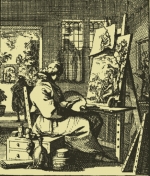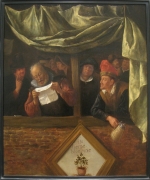Wrote Letter L-011 of 1674-06-01 to Henry Oldenburg about movement of liquid in capillary tubes, structure of body parts, growth of skin, and the size of red blood cells
Text of the letter in the original Dutch and in English translation from Alle de Brieven. The Collected Letters at the DBNL - De Digitale Bibliotheek voor de Nederlandse Letteren
The original manuscript on six folio pages, written and signed by Leeuwenhoek, is preserved at the Royal Society (MS. 1881. Early Letters L1.4). For the packets with 25 specimens, see Royal Society Museum Objects MOB 013. See also Letter L-018 of 4 December 1674, Letter L- Early Letters L2.1, and L2.16.
An excerpt was published in Philosophical Transactions, vol. 9, no. 106, dated 25 October 1674. See Publication history below.
Leeuwenhoek wrote this letter to Henry Oldenburg about movement of liquid in capillary tubes, structure of body parts, growth of skin, and red blood cells 2500 times smaller than a grain of sand. A small envelope containing four small packets was attached to the last sheet. Three of the small packets contained specimens: of cork; of pith of elder; and the white of a quill.
Over a year after his first letter, Leeuwenhoek described, for the first time, red blood cells and emphasized their tiny size. He first began to deal with an ongoing problem: what he was observing had not only never been suspected by anyone. It was also, on its face, "incredible".
First, he disclosed his procedure, referencing a drawing (below):
I shall herewith communicate the Manner how I have observ'd, among other things, Blood and Milk.
I did my self prepare divers sorts of very slender hollow Glass-pipes (See Fig. 1) as A B, of which some were not thicker than a mans-hair; and the slenderer they are, the clearer will they make the red Globuls of the Blood appear. But, for seeing the Crystalline water in which those Globuls move, and for observing also how they subside, these Pipes may be made somewhat thicker. ...
Note that he realized early on that the glass pipe itself can act as a lens. Just as smaller lenses were more powerful, so, for the same reason -- increased radius of curvature -- "slenderer" pipes made the blood appear more clearly.
This pipe with the blood in it, I lay upon a piece of white paper and with my nail break a little piece from it, as Fig 2d or 3d; and set it to the pin of my Microscope, having first a little wetted the pin with my spittle or a little turpentine, to make the pipe stick to it; or else I take the whole Glass-pipe, and with my hand hold it before the microscope.
Not only does he reveal his procedure and enclose a drawing of his pipe:
And that the Curious in your parts might themselves see this, I have used the freedom of sending you some of the said hollow Pipes, by the means of which I hope my above-mentioned speculations will be verified.
He also sends some of the pipes themselves, and then tells why. The hair that he used in an earlier letter as a measure wouldn't work here, so he used another measure that he would often repeat: the grain of sand.
The red Globules of the Blood I reckon to be 2500 times smaller than a grain of sand; which perhaps will to many seem incredible.
Then he shows the arithmetic that produced his "incredible" number:
'Tis known that, two Globes being given, the axis of one whereof is 1, and that of the other 20, the proportion between their magnitudes is an 1 to 8,000.
Later in the same letter, he has moved on to discuss his special pipes and his technique for getting a cow's brain tissue in front of his lens. Again, he was forthcoming about his tools and methods:
Now that the Curious may be assisted to view the particles of the brain, I herewith send also some Glass-pipes, by me contrived for that purpose.
He included drawings of these pipes, also (below). In addition to the two different kind of pipes, Leeuwenhoek also sent samples of his specimens in little envelopes so that his observations could be verified.
Which kind of progress of growing I apprehend may in some manner be seen in the Pith of Wood, in Cork, in the Pith of Elder, and also in the White of a Quill; of which three last I have sent you and your curious Friends some small particles, cut off with a sharp Pen-knife, thinking it well worth their observation.
The cork and elder were among the samples recovered by Brian J. Ford in the late 20th century and discussed in The Leeuwenhoek Legacy, where he looked at them through some of the surviving lenses. Thanks to Ford, we know now that indeed, Leeuwenhoek had a tool that let him see what he claimed to have seen. Leeuwenhoek then added a few words about technique.
Only I would here advertise, that when any of these particles is applied to the pin of such a kind of Microscope as mine is, the instrument may be held within doors and in the shade, yet held to the free Air, as if with a Telescope you would look upon the Stars in the Firmament.















